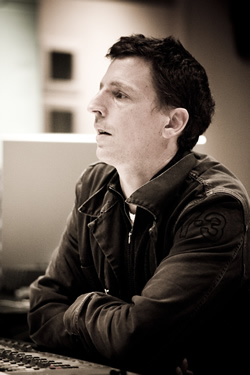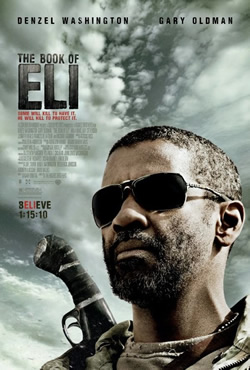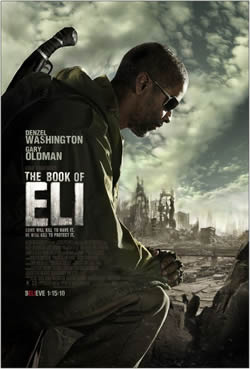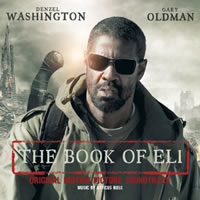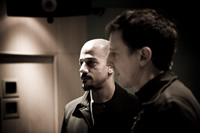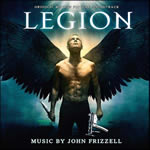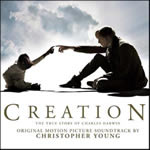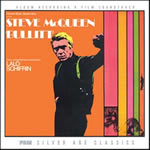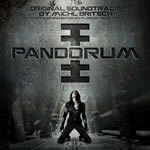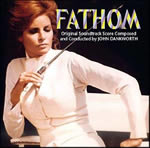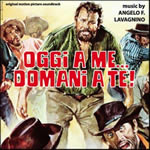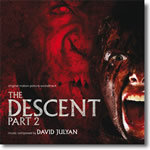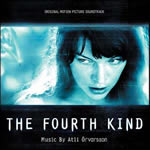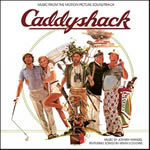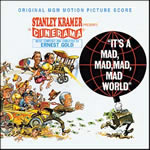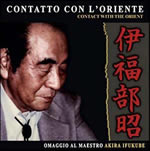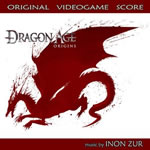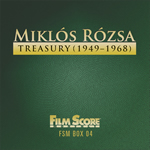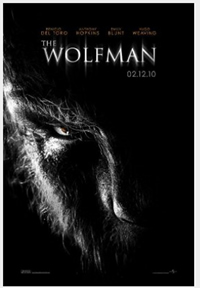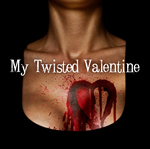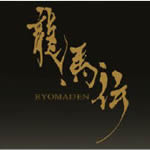
 |
Soundtrax: Episode 2010-01
January 31st, 2010By Randall D. Larson
The Music of Eli
Atticus Ross
A Conversation with Atticus RossTHE BOOK OF ELI, which opened January 15th, is the latest film from the Albert and Allen Hughes (From Hell, Dead Presidents). The metaphysical yet ambiguous post-apocalyptic story tells of a lone man, Eli (Denzel Washington) who fights his way across the ruins of America in order to protect a sacred book that is said to hold the secrets to saving humankind. The film marks the third collaboration between the Hughes Brothers and composer/musician/producer Atticus Ross, who also makes his feature film debut with this score. Ross’ music is a powerful hybrid score of electronic and organic elements, writing in close collaboration with his wife (Claudia Sarne) and brother (Leopold Ross). The basic tracks were recorded at his Los Angeles home studio before journeying to London where the performance of an 80-piece symphony orchestra was recorded at Abbey Road Studios and merged with the synthetic tracks already realized.
Ross has incorporated his musical style into collaborations with such contemporary artists as Nine Inch Nails (Ross collaborated with Trent Reznor on four of their recent albums and has played with them live on stage), Jane’s Addiction, and Korn, many of whose albums Ross produced. Warner Bros. has released the soundtrack album in four unique configurations: standard CD, a digital version available for download through the usual providers, an exclusive digital iTunes edition featuring a remixed track by Dave Sitek, and a vinyl version due out in February.
Interviewed the week before Christmas, I discussed the score with Atticus, who described his approach to scoring the film and working with the Hughes Brothers.
Q: How did you get started working with the Hughes Brothers?
Atticus Ross: I’ve worked with them over the last few years. It wasn’t like a prolific period, but maybe the next few years will be! I first worked with them on a TV show called TOUCHING EVIL. Allen [Hughes] called me up – he’d heard some music I’d done and was interested in whether I could, just on spec, write some stuff. It ended up that he really liked it. I usually work, certainly on the film music, with my wife and my brother. TOUCHING EVIL was just a fantastic series, and I ended up in a place where I became good friends with Allen, and then we did this short from the [anthology] movie, NEW YORK I LOVE YOU. And then that fell into THE BOOK OF ELI – but that was probably for at least a year and a half before it went into production. The thing with the Hughes Bros. is we always do a portion of the music before they start filming. In this case, the main theme was written before the cameras started rolling.
Q: How did you work with the two of them on THE BOOK OF ELI?
Atticus Ross: They divide their work – Albert does the storyboards; he’s the guy working out the shots and the look, although they do look at it together. Allen is more the guy who works with the actors, and it’s the same with the music. Allen has a certain aesthetic and he hears in his head the certain direction that he’s going to go, musically. But at the same time, he’s not leaning over your shoulder when you’re trying to write something.
Q: What type of ideas did you have initially for the score?
Atticus Ross: We’d discussed how they wanted to approach it – not necessarily just the music, but in terms of the whole film. One thing that was really helpful on this project was a book they put together using iPhoto, which was a really great vision of what this film was going to be. It wasn’t necessarily like, here’s a picture of Eli – it was more a collection of images and quotes and ideas that they’d assembled that they wanted to do with this film. That, alongside just sitting down and talking and sending records and movies back and forth, gave the idea of where I should be, musically, with respect to where they were going. Then it was a case of sitting down and writing. I think I wrote twelve pieces for them initially, and they found maybe three of them that they liked, and that was the direction they wanted to go. There were some specifics we were talking about, but we started discussing the overall atmosphere. The thing with the film is that it’s not an action film, but it’s not just a drama, either. It’s an interesting film in that it really covers a gamut of things. Ultimately it’s about the journey – someone’s spiritual journey. So how do you put that into sound? The essential idea was to do what they were doing in terms of the film. The film is dark and very washed down, and then as it progresses the film becomes more powerful. So, musically it starts very tonal and then becomes more orchestrated toward the end.
Q: After filming was completed and you had some footage to look at, how did the score develop into what it is now?
Atticus Ross: It became a lot more focused. There are a lot of horns in the score, and I really love the sound of horns. That was something that got sparked off by Gary Oldman’s character. Saying that, it sounds a lot cornier than it is on the score – it’s not like he walks on and suddenly the horns start! But they did give a heaviness to him and they also cast him opposite Eli, who was more spacious and aspiring, at the end. I think the stuff with Eli came about pretty easy, and there was some other material that developed over the time. It was an interesting path.
Q: It sounds like you had the initial opportunity to get your ideas down, free of specific images or specific moments, and to get a general sense of what you want the score to be, and then bring it into the realm of timings and specific scenes.
Atticus Ross: Yeah, exactly. And sometimes the general stuff only serves as a guide. I’ve found what we got to was an atmosphere for the film; it didn’t necessarily mean that those pieces were going to fit. They gave me a guideline to write within. The thing I found interesting about film, and maddening, as opposed to records, is how much it changes, constantly! Even in the week leading up to the orchestra sessions, huge edits were made to the film that completely changed the music considerably, and I’m trying to keep up with it in one way or another!
Q: How would you describe your musical background, and the journey that brought you to scoring this large scale type of film?
Atticus Ross: It’s been broad, and it’s been much more than I thought it would ever be. I’ve never really been a person that envisioned I’m going to be here, or by this time I’m going to be there. I’ve just kind of gone with it as things have gone, and I think I’ve had the opportunity to work with a lot of very talented people over the years. For me, even if I’m producing a record, I still like to take a chance with someone who’s learning and who is remaining teachable. I think there are some people – and I don’t know enough about film, but certainly in producing records – who do this thing and they just do it again and again and again, and that’s what you get. I’m not criticizing that, but I’m saying, for me, I always feel excited about the opportunity that maybe it could be different next time. I could try this or that or whatever. The simple fact of getting to work with an orchestra on this has been a huge, exciting thing for me. Having an openness to changes and a broadness in what interests me has been important to me. I do feel good about the score, and I think it was a combination of my own specific musical background and openness, and also this being just one of those projects where things go right. Everybody involved was in to it. I’m not talking just about the music, but the whole process. It’s just one of those ones where it felt like it had its own life.
Q: Your score also has an intriguing combination of the electronic and the orchestral. We’ve seen that, especially in science fiction and fantasy, which started out orchestrally and then when the electronic revolution came about the scores became purely synthetic for a while, but now over the last couple of decades we’ve seen this amazing integration of the organic and the electronic into a hybrid orchestration. THE BOOK OF ELI fits very well into that, as far as taking it into another level.
Atticus Ross: I’ve noticed that slightly different in America than in England. It’s not like I’ve ever felt any division between the two or that I’ve ever felt now I’m doing something that’s not electronic music or now I am. I think that is partly an English thing, because I do have friends here who work with bands all the time, and MIDI is still a terrifying thing to some of them. But it’s always kind of been part of the same thing to me.
Q: How would you describe your technique of working with your wife and your brother to set down the basic tracks, and preparing it all, knowing you’re going to be combining that with the large orchestra at Abbey Road?
Atticus Ross: Everything was written with the strings and all of that in it. It just wasn’t played by an orchestra – it was synthesizer strings or sampled strings. We had all the parts and everything set up for it all. And then it just got taken to another level by the real players, and really by brilliant orchestrations by Dana Niu. The beginnings of it were just really hard work and chance, that journey just to get to the right place. Once we had that guide to what we were trying to do, like I mentioned before, it fell in even more. And also, we had a bit of time to do this. I took probably a bit more time than average. I’m sure that someone who composes films all the time puts everything on a regular schedule, but this was done off and on over six months – not working on the film the whole time, there were some other things going on. Around this time last year we did the first bit of writing and then had a couple months off, and back on for two, that kind of thing.
Q: What was most challenging for you about this score?
Atticus Ross: Getting over my insecurity! I found I had to detach myself from the idea that it is a big film with big stars and all that, and just put it back into a much more modest setting in my head – and literally as well; most of it was done at my house. But I think it came out really well and I’m proud of it. I definitely think there were times during the process where if I’d had more experience I probably wouldn’t have gone off down certain roads that I did, but it’s an interesting scenario because it’s so different from making records. Ultimately the record is the sum total of the work that’s done, but with a score I’m really subservient to the film. I’m just a cog in the machine! But the Hughes Brothers encouraged everyone so well – it was an education to learn the technicalities of having a scene to write and working around dialog and everything.
Q: In doing that, did you feel any particular type of need to repress what you wanted to do, or did the Hughes Bros give you a free hand as you were working the score out?
Atticus Ross: They gave me a good free hand. I’m sure that there were things that I saw differently, and there were certainly changes made on the dub stage, which is apparently a common thing. Sometimes they saw it differently to how I saw it. But I wanted them to have whatever they needed, so it wasn’t like I was attached, in a negative way, to what I wrote. I think that there needs to be an element of being able to let go, in all of life.
Q: It’s like the difference between working as a soloist and then working as a team player. You still have the ability to go back and do the other.
Atticus Ross: Exactly. Everyone was saying – I’m talking about the music supervisor and staff people like that who were experienced and had done a lot of films – there was a sort of unique sharing of vision, like I mentioned before. Alcon is the company that made the film, and even though it’s a Warner Bros picture it’s actually an Alcon Entertainment film, and Alcon was the independent company I worked with. The reason I bring it up is because I never really had that thing that you hear about, where a lot of executives are breathing down your neck and giving you notes and all that stuff. The only notes I ever got from the producers were things like “hey, we really like it! Keep doing what you’re doing!” That’s why I feel really good about this experience. Who knows, it could have been the other way! But I think there’s an aspect of letting people do what you want them to do. If the Hughes Bros wanted the kind of thing that I was able to do, there’s an aspect where they have to be able let me do it, and I think that in this film there definitely was that. The Hughes Bros were very encouraging and everyone else was as well.
Q: Was there a need to acknowledge the science fictionesque, fantasy, and spiritual elements of the story? Did any of that affect where you were going with the score?
Atticus Ross: It wasn’t like fantasy or science fiction were major elements. Of course we’re dealing with a post apocalypse environment, but Allen was saying that Eli is a man on a journey – he could be on earth or maybe he’s somewhere else, you know? And I think it’s cool in that way. In terms of the spiritual side of it, all the stuff that’s been on the Internet as far as whatever the book might be, is it the Bible, is it this or that? The whole film is all metaphorical, in terms of what it’s really throwing out there. It’s a question, and that in itself makes it a unique film. You can take things how you want. The fantasy aspect, to me, and fantasy might not be the right word, but there is a sort of otherness to a lot of it that we were trying to reach, because of the nature of the story. There’s a literal journey that happens in the film, but the real journey is Eli’s personal one.
Q: And that’s something that music can especially evoke, because music is always dealing with the underlying emotional/psychological/spiritual aspects of what you don’t see on the screen.
Atticus Ross: That’s certainly what we were trying to reach for. And it was as well because they never wanted specific music. The Hughes Bros never wanted that thing where if it’s a sad scene you give it sad music. It was intentionally never that literal. In fact they were very clear in not doing that. So that also was an education.
Q: What will this bring about for you in the future? Do you want to do more film work, or do you want to maintain this ability to do different things?
Atticus Ross: I would love to do another film. We’ll have to see whether anyone wants me to! But I’m actually doing a bit on a couple of things at the moment. I’m leaving it open. I’m going to go off and do some record stuff at the beginning of the year. But I would love to do another film, it would be really great. THE BOOK OF ELI was a really great experience.
For more information on The Book of Eli soundtrack albums, see: http://bookofelimusic.com/
New Soundtrax in Review
THE BOOK OF ELI isn’t the only metaphysical fantasy film with spiritual overtones making the rounds this new year. A number of other major releases also touch upon spiritual issues to one extent or another. John Frizzel has written a very expressive score for LEGION, a supernatural horror thriller in which an unhappy God, losing faith in an increasingly amoral humankind, sends his legion of angels to bring on the Apocalypse. The only hope for humanity lies in a group of strangers trapped in a desert diner with the Archangel Michael. The soundtrack album, released by La-La Land Records, contains 25 tracks and 51.4 minutes of exquisitely flavored tonality. Frizzell writes in the album notes that he was eager to try out some new synthesis ideas on this score. With a base of orchestral strings and low brass (no woodwinds or trumpets at all), he created a “web of synthetic sounds that would evoke the supernatural, the divine, and the horrific.” Central to this concept is a group of “melodic timbers” he calls “frozen sounds” which were created by “taking one or two second audio files of different instruments and stretching them to 30 seconds or more using various audio processing software.” The result is an atmospheric texture that “feels both electronic yet very human and expressive at the same time.” Frizzell uses this sonic texture to create a layered atmosphere which drifts across the film’s sonic dimension like moonlit wafting desert dust, driven by mercato strings, embellished by lots of eerie dimensions in the orchestrations. The score has an interesting progressive pattern, beginning with chilling dissonances and menacing, evil-dripping ambiances as the moral battle between good and evil commences in the desert. As the story develops and the story focuses on the factors representing good, and the willingness of Gabriel to continue its onslaught against humanity, the music assembled into a more purposeful motion, congealing into a clearly focused rhythmic progression of layered harmonic textures, ultimately arriving at the gentle, triumphal cadence of “You Are The True Protector” (which is also presented in an alternate version with a somewhat different orchestration). Frizzell’s orchestration and integration of the organic with the synthetic is expressive and admirable in the LEGION score, and its journey from dissonant, incongruent and chilling patterns of sound textures into a driven, harmonically united semblance of confident rhythmic expression is both conceptually and musically very compelling, resulting in one of the composer’s most satisfying recent works.
A more historical examination of a conflict between faith and once-radical science is found in Jon Amiel’s CREATION, which tells the story of English naturalist Charles Darwin’s struggle to find a balance between his theories on evolution and his relationship with his religious wife. The music, by Christopher Young, has been released on CD by Lakeshore in the US and by Silva Screen in the UK. This is Young’s fifth collaboration with Amiel (after COPYCAT, THE MAN WHO KNEW TOO LITTLE, ENTRAPMENT, and THE CORE). The music is sumptuously expressive, evoking an almost spiritual attitude in its harmonic beauty. The music evokes the 19th Century period slightly in the style of its eloquent violin soloing and piano movements, but otherwise Young focuses on providing a consistently lovely non-thematic pattern of melodic ambiance. What Young has done so well in his horror scores to evoke a progressive, layered texture of terrifying sound design, he accomplished here to evoke the beauty evoked by the design of the natural world, and the exquisite heartbreak of grief and guilt. In fact, CREATION is not so much a history on Darwin’s Origin of Theories or the tightening conflict between Religion and Rationalization, but a touching delineation of one man’s personal grief that itself drives his naturalistic compulsion to complete his work. Young’s score becomes a tone poem for a myriad of static emotions: sorrow, regret, guilt, grief, wonder, anguish. The primarily musical patterns drift above and washes over the film with a degree of motific and timbral development, but it essentially remains as constant as the tangible grief and guilt that torments Darwin and his wife over the death of their young daughter. Somewhat more energetic moments from strings and winds in “Cunning Gunning” and the growing interplay between oboe, strings, and piano in “Pleasure Perfect,” while a lively waltzlike interplay between piano and strings serves as a romantic motif for Darwin and his wife, Emma; a similar but far sadder interaction of piano and strings exudes Darwin’s regret in “The Ghost Pavanne;” a plaintive oboe in “Unity in Form” evokes Darwin’s growing awareness of the natural world; while the opening cue, “Creation,” ironically transposes the very antithesis of its title by evoking the death of young Annie with a drifting sonority of strings and winds. This fatalistic melancholy is fundamental to both story and score, despite advances in Darwin’s work and his relationship with wife Emma; the music at its heart remains characterized by overlapping layers of lyrical tonality that drift across the soundscape, forming an incredibly serene resonance that doesn’t need a melodic hook or a final resolution to give it any more meaning than it already possesses. It is one of Young’s finest works to date and a thoroughly captivating listening experience on disc.
Lalo Schifrin’ score to BULLITT, Peter Yate’s iconic cop movie from 1968, is one of the finest jazz-oriented scores of the 1960s, and admittedly a personal favorite of mine. The score has had a life of its own on LP and CD, beginning with a 12-track soundtrack album released on LP by Warner Bros at the time of the film’s release. It’s that album which subsequently found its way onto CD by Warners in Europe and SLC in Japan; but that 1968 album was not an original soundtrack but instead a re-recorded session done by Schifrin to emphasize jazz arrangements of the score’s major moments. In 2000, Schifrin re-recorded the score again to provide an extended score CD release issued on his Aleph label (and by Warners in France); for that album Schifrin replicated the album arrangements but also recorded the original film arrangements of three cues. With their December Silver Age Classic recording, FSM finally presents BULLITT in its original movie soundtrack version, with Schifrin’s 1968 album re-record added as well. Comparing the film versions with the album re-record is a stunning experience, especially for those who know the score more from its album than its movie presentation. Only a few tracks are arranged the same. The musical elements are the same, but the arrangements are like night and day. Take the Main Title, for example. On the re-record it opens with Schifrin’s signature low bass riffing and goes right into the jazzy guitar licks of the main theme. The film version, more than a minute and a half longer, opens with furtive strings and drum kit, pensive blares of brass, the familiar bass riffing emerging in a slower and more careful introduction, the main guitar theme played lower in the mix beneath a rhythm of cymbal and snare, the saxophone counterpoint sounding far more interesting a resonant. The development includes a much more languid bridge for percussion, more of the soft flutes as the length of the film’s title sequence afforded a more intricate and interestingly developed musical introduction. The score’s showpiece, “Shifting Gears,” (the foreplay to the famous chase scene, which was not scored with music but with raging motor and screeching tire sound effects), is essentially the same, with only some minor alterations in timbre and mix and a more prolonged brass swell at the end. The film version of “Ice Pick Mike” affords a much more satisfying amount of suspenseful chase music rather than the straight jazz fusion rendition of the LP version. Having the original film tracks is like finding buried treasure. Both of Schifrin’s re-records of the score’s main elements were fine and did justice to the music – but hearing the music in its original soundtrack arrangements is an entirely different animal. This is an extremely important release in that sense, and aptly demonstrates the difference in hearing flowing jazz interpretations and hearing music that ebbs and flows and drifts along with the cinematic flow of the story on screen. There are 19 original film tracks on FSM’s release, versus the 1968 LP’s dozen tracks (or the 18 on Schifrin’s 2000 re-record, of which only 3 were movie versions, and 3 were previously unreleased), which includes a healthy dose of cues never before recorded – and some, having been dropped from the film prior to release, never before having been heard until now. The new CD concludes with a previously unreleased demo version of the main theme (possibly in anticipation of a vocal version prepared – but never recorded – for a party scene); it’s arranged similarly but has more funk and a more strident saxophone playing. John Bender provides thorough analysis of the film and its score in the album notes, while Alexander Kaplan describes each track in detail and identifies each difference between the album and film version of those cues appearing on both. BULLITT should be an essential score for any serious film music collector or devotee; this album, released in a limited edition of 3,000 copies, is clearly the essential version of that score.
In PANDORUM, German director Christian Alvert’s sci-fi horror thriller recently released on DVD, the two crew members aboard a spaceship wake up with no awareness of their mission or who they are – and they soon realize they are not alone. The score is by Michl Britsch, who scored Alvert’s previous horror films (ANTIBODIES, 2005; CASE 39, 2009), is a weighty hybrid score that crafts a haunting sound design that definitely ups the scare quotient in Alvert’s new film. It’s less effective on disc, where it’s intent at building fear and fright is less necessary (the oscillating drone of the title track and “Shape,” for example hard to listen to, as is the sonic brutality of “Hunting Party,” which are thoroughly aggressive industrial orchestrations powerfully effective in the film but that aggressive dissonance is less satisfying to me for home listening, although the cue does feature an intriguing female vocal pattern midway through its charging aural onslaught; the percussively driven cadences of “Kanyrna” build a disturbing sense of claustrophobic unease), but it’s still a powerful work which, in its more atmospheric and less scarily assaultive moments becomes quite compelling. The opening track, “All That Is Left Of Us,” for example, and “Anti Riot” proffer some intriguing textural rhythms; “Scars” possesses an accessible melancholic sensibility; “Fight Fight Fight” combines some worldbeat ethnic vocalizations with a spiraling sinewy synth pattern that increases in velocity; while the 16-minute pair of final tracks fuses the score’s terror-inducing drones, synth pads and riffs, and percussive patterns into a climax of disturbiana. It’s a very good score on film, and Britsch develops some powerful sonic textures and synth patterns, but like many horror scores of this style, is less effective as an isolated listening experience.
British composer and jazz recording artist John Dankworth scored FATHOM, a 1967 spy spoof starring Raquel Welch as a skydiver recruited to work as a spy for an uncertain Western intelligence agency, with jazzy pop and dizzying romantic measures. Released on LP in the US at the time of the film, the soundtrack album has been reissued on CD for the first time by England’s Harkit Records (they also released Dankworth’s earlier Britpop score to another spy spoof, MODESTY BLAISE, in 2001). The score is a mix of breezy pop, jazzy and sensuous lounge, lush choruses, and trendy bossa nova and tango dance. It’s a pleasing score from the swinging 60s. Dankworth also provides a sumptuous romantic theme, “The Merriwether Affair,” and a suspense theme done a la tango in “Tango Sinister,” and the choral driven action cue “Chorale to a Scuba Diver,” which provide somewhat more dramatic intonations; the latter an especially interesting combination of lounge chorale with dramatic action riffing, as does “Vacation Chase.” Album notes by Cinema Retro’s Darren Allison provide background on both score and composer – although I wish they would have used the original LP cover art for their front cover that the rather dull image of Raquel they selected (the LP cover does appear behind the CD tray).
Angelo Francesco Lavagnino’s tuneful music for the 1968 comedy Western, OGGI A ME… DOMANI A TE! (“Today It’s Me, Tomorrow, You!”, better known in the US as simply TODAY IT’S ME) received its first ever release in any form (outside of a member of a compilation LP) from Digitmovies of Italy. The film starred an international cast of Italian Bud Spencer, American Brett Halsey, Australian William Berger, and Japanese Tatsuya Nakadai in a story of betrayal and revenge in the Wild West. Lavagnino’s main theme houses a classic Italian Western theme but wraps it in a lighter, gentler pop sensibility. It sounds fine and is very likable; but it doesn’t have the intensity of some of the composer’s more dramatically-oriented themes. The theme is reprised thrice in succeeding tracks, one combining it with the motif of the rhythmic suspense cue “Insequimento A Cavallo” which, unlike the random noises of many Italian Western suspense tracks, Lavagnino proffers a consistent rhythm beneath his percussive raps. “Bandidos” is another percussive suspense track, timpani and snare and ominous organ, ending in a brash organ melody doubled by strings. Flailing trumpets crowd over rolling timpani in the action cue, “Attacco Alla Diligenza, snare drums roll beneath a piping trumpet in “Marcia Di O’Bannion,” while “Ricordo Di un Amore” proffers a tender love theme for strings and musicbox-like xylophone. Another suspense cue, “Come Un Samurai,” for the showdown with Nakadai, contains an interesting mix of Western percussion and Japanese percussive elements, evoking the homeland of both characters as they face off. There are also a trio of original honky-tonk piano tunes written for Saloon scenes. Digitmovies’ album contains De Masi’s complete score in its original mono recording, with notes in English and Italian by Claudio Fuiano and Luca Di Silverio.
Composer David Julyan returns to the claustrophobic mines of the hugely successful 2005 horror film THE DESCENT with its sequel, THE DESCENT, PART 2, soundtrack now available from MovieScore Media. The sequel score further develops the ominous and powerful musical landscape the composer created for the first film, a “detailed meld of acoustic and electronic music,” as MSM puts in. Very much a part of the hybrid school of contemporary horror scores, Julyan provides a haunting and drifting ambient sonority that descends darkly into the thickly textured depths of aleatoric techniques and brazen dissonance, as Sarah, the lone survivor from the first film’s onslaught, is forced by the mistrusting authorities to return with them to the Appalachian cave system to find her missing friends. Like the first score PART 2 is non thematic, but an atmospheric score comprised of layered musical tectonics and dark, tonal motifs that rise up and then submerge into inky blackness, developing a tangible sense of claustrophobic unease that surpasses the first film’s spookiness. Julyan’s sonic tendrils wait in the darkness, just out of sight, but not out of reach, instilling in the viewer/listener the certainty that something is out there, something with sharp claws and sharp teeth and a raging hunger, and it will be upon them with jagged, tearing limbs and snarling jaws once they step into that darkness. Percussive rhythms propel the score’s shafts of sound in purposeful angles, halting to allow its exuding chord patterns to build and reach higher (or deeper) levels, while low, sustained exhalations of gloomy tonalities drift like yellow smoke through the cavernous depths, finally, in the last track, the layers ascend, rising in slow, painstaking steps to finally resolve themselves in a weary exultation of triumph. It’s a powerful work. Also, because it’s more tonally ambient than chaotically dissonant it works well on its own, apart from the film, as an intriguing listening experience. Especially if you’re having second thoughts about going caving the day after.
Incidentally, for its CD releases, MSM has announced it is switching from digipaks to jewel cases for its packaging. (For what it’s worth I’ve always preferred the digipaks for their durability, but apparently the majority of MSM’s collectors opted for the breakable plastic cases. Humbug!).
Atli Övarsson’s score for Milla Jovovich’s close encounters of THE FOURTH KIND is out from Varese Sarabande. The film, a muddled attempt to incorporate fake “real documentary evidence” of alien abductions into a plausible storyline that never seems to congeal into anything plausible, is nonetheless benefitted from Övarsson’s scary ambient film score. It’s in the sound-design school of horror scores, but is quite compelling in its tonal range and developing timbres. Övarsson builds a strong element of apprehension in his score, which gives the film a lot of its emotive potency. It’s comprised mostly of a slow moving cadence of tonal chords, a formulaic approach but one that the composer delivers with powerful efficiency. Övarsson uses choir exquisitely in “Flight to Nome,” “Torn Apart,” and the film’s unresolved “Conclusion,” while a poignant piano motif gives “Ashley,” Jovovich’s character, a sympathetic edge when she realizes she’s more than just an outside observer of the abduction epidemic that has struck Nome, Alaska. Reflective tonalities over percussion and tubular bells create a mesmerizing motif for the aliens in “They’re Not From Here;” Övarsson’s sharp, rapidly struck tubular bells midway through provide an effective counterpoint to the slowly drifting textures of the cue’s ambient material.
Speaking of Övarsson, check out his excellent score for a far more reliable true story, THE LAST CONFEDERATE, available via www.strongbowpictures.com/thelastconfederate/
Varese Sarabande has also released Nathan Barr’s score for the TV series, TRUE BLOOD. Debuting in 2008, Alan (SIX FEET UNDER) Ball’s new show was an attempt to capture on the small screen the strange allure of the vampire romance, â la Buffy and Angel in BUFFY THE VAMPIRE KILLER and more recent and less tolerable exercises in teenage romantic angst like TWILIGHT and its ilk. Barr has given TRUE BLOOD an organic sense of authenticity in its acoustic score; the music feels right for the show’s backwoods Louisiana setting and characters, while also accommodating the landscape’s newest denizens – vampires. “I simply float along underneath the actors, rising here and there to accent particular moments,” Barr notes in his composer’s note. “In addition to guitar and cello, I also play an electric bowed guitar and an old upright piano that has been sawed in two so I can access the harp strings and prepare them however necessary, striking them with hammers or steel drum mallets. These four instruments make up the heart and soul of the score in TRUE BLOOD.” Barr’s use of prepared piano (usually accomplished with a grand piano, not an upright) generates a unique timbre to the music, enhanced by the various sonic accoutrements with which he has prepared them to generate even more unusual textures. It is especially well represented in “Gran’s Story,” “Priapism,” and “Amy’s Goodbye.” The album, drawn from the first season, provides an array of Barr’s intricately arranged motifs and ambiances, from the dark, alluring cello of “More Than You Can Imagine” and the reflective acoustic guitar and cello of “The Cabin,” interrupted as it is with a frenzy of wild violin bowing that makes Charlie Daniels sound like a somnambulant fiddle player. The cue progresses through an assortment of reverberates pianistic sounds and eerie, reflective electronica as it drifts into fairly nightmarish country and then out via the violin riffing of “Bill and Sookie.” Introduced in the delirium of “First Taste” and developed further in “Tripping” is a haunting, twisted orchestral glissandi with reverberated electric guitar, evoking a strange sonority of unreality, while the Morriconesque harmonica opener of “The Tribunal” leads into a rough glissando of low piano strings and a gloomy electric bowed guitar refrain underlined by steady and very menacing low synth, opening into a rhythmic kind of folk dance from electronically-tinged instruments, driven by a fatalistically pounding piano until it all begins to unravel into an untwisting crescendo and dissolution. The main recurring theme, aside from minor ambient motifs, such as the sonorous cello melody, reprised here and there, is the fiddle theme for Bill the vampire and Sookie the barmaid and mind reader. The fast rhythmic strings, acoustic guitar, and resolute piano of “Bill’s Entrance,” “Bill and Sookie Together,” and “Bill and Sookie’s Reunion” and likable and reflect characters who the audience has grown/is growing fond of. A secondary theme for Sookie’s brother, Jason, and his not-long-to-love-as-a-human girlfriend Amy is a compelling slack guitar riff over sinewy, drifting violins and synth, heard in “Amy’s Goodbye” where it is offset against a percussive prepared piano sound in high register giving it an unhappy foreboding, and in the straightforward “Jason And Amy.” A love theme for beautifully fingered piano resonates with both excitement and menace, closing out the album with the ongoing reminder of Sookie’s dalliance with a vampire is flirting with dangerous moonlight. The album includes Lisbeth Scott singing the song, “Take Me Home,” from Episode 6, and the Scandinavian folk chant performed by Scott and Nathan himself, during Eric’s bathtub scene in Episode 8 (Barr has noted online that the song’s the lyrics “are translated from an Old Swedish epic poem about a king named Eric – the writer of this episode Alexander Woo contacted a university professor who knows Old Swedish who recommended this particular text because of its focus on a king named Eric”). The intriguing sonic textures of TRUE BLOOD make it an extremely likable score on CD, especially the folksy quality of the Bill and Sookie theme; especially in “Bill’s Entrance” where the rhythmic melody gives way to the haunting cello theme representing the darker side of Bill. It’s not a heavy horror score, either, although it has its share of anxious and scary sounds, but its focus is on the environment and, especially, the characters and their interrelations. The show remains so much more interesting than the blatant adolescence of TWILIGHT, giving Barr more to work with, and in turn, his music gives TRUE BLOOD its solid musical grounding.
Among the three iconic comedies that that defined the late 1970s and set the standard for all such event comedies that followed – ANIMAL HOUSE (1978), THE BLUES BROTHERS (1980), and CADDYSHACK (1980) – only the latter was denied its soundtrack on CD until now. All three soundtracks were song heavy and were successful albums for that reason, although each had significant if brief elements of original scoring, by Elmer Bernstein on the first two, and Johnny Mandel on the last one. Fortunately, the team at La-La Land Records has reissues the CADDYSHACK soundtrack LP in a newly remastered package that includes thoroughgoing analytical notes and written commentary by Daniel Schweiger, outlining the genesis of the film and its use of music. The most familiar music, of course, are the songs by Kenny Loggins, especially the tune, “I’m Alright” which accompanies the front and end titles, the latter especially entertaining as the credits paraded over a shot of the film’s real star, the gopher, dancing in triumph. Mandel had more of an impact in the realm of jazz and popular vocal music (he arranged for Sinatra, Streisand, Peggy Lee, and others), although he was successful in scoring more than fifty film and TV episodes, the most memorable of which were the jazz-infused I WANT TO LIVE! (1958), the passionate romance of THE SANDPIPER (1965), the militaristic screwball antics of THE RUSSIANS ARE COMING! THE RUSSIANS ARE COMING! (1966, which recently had its soundtrack debut on CD in FSM’s 2008 “MGM Soundtrack Treasury” boxed set), John Boorman’s crime thriller POINT BLANK (1967), and, perhaps most memorably of all, Robert Altman’s M*A*S*H (1970). He also scored Disney’s body-switch comedy, FREAKY FRIDAY (1976, remade in 2003 with a nice Rolfe Kent score) and the “One for the Road” episode of AMAZING STORIES (1986). As for CADDYSHACK, Mandel’s music includes a satirical, faux Wagner epic music, “Divine Intervention,” a big of restaurant jazz source music (“Marina”), and the massive, 1812 Overture-ish “The Big Bang” replete with explosions as Bill Murray’s slovenly Groundskeeper Spackler attempts to decimate his arch-enemy, the gopher – although as Schweiger points out, Mandel actually wrote “tons of stuff” for the movie but most of it was the abundance of musical in-jokes and bridges that appear in minute fragments throughout the movie’s soundtrack (and which were therefore impractical to record due to their brief duration). La-La Land has done a fine job in remastering and reissuing the 1980 LP, including the four primary Loggins songs (including the complete end title version of “I’m Alright”), songs by Journey, The Beat, and hyperventilating Hilly Michaels (drummer for the band Sparks). It’s an uneven soundtrack in terms of musical style, but it fit CADDYSHACK like a tight pair of golf pants. Mandell’s over-the-top score mixes well with the energetic rock and roll, and the Cd is definitely one fans of the movie will want to gopher.
It was the ANIMAL HOUSE, BLUES BROTHERS, and CADDYSHACK (rolled into one) of the 1960s. Stanley Kramer’s IT’S A MAD, MAD, MAD, MAD WORLD (1963) was a huge ensemble comedy – intended by Kramer to be “the comedy to end all comedy” – with dozens of cameo appearances by nearly all the big comedy stars of the day. A huge madcap chase as several groups of motorists race each other to find hidden money described by a man dying from a car crash, the film was enlivened by a carnivalesque score by Ernest Gold, in a riotous musical about face after having scored Kramer’s somber Nazi drama, JUDGMENT AT NUREMBERG two years before, and Otto Preminger’s massive historical drama, EXODUS, in 1960. Gold’s theatrical, effervescent, and melody-rich score, merging orchestra and singing chorus and all manner of clever and adroit themes for various moments in the screwball chase, enhanced the film’s action and adventure, while leaving plenty of room for Kramer’s comedy and that of his splendid cast. Originally released on LP by United Artists, like many of the movie scores issued on LP in the 1960s, that album was a rerecording, and United Artists edited in various dialog snippets at the end of almost every track. Ryco reissued it on CD for the first time in 1997, keeping the dialog excerpts but separating them from the musical tracks. With Kritzerland’s newly released version we have the complete music-only tracks from the score album, which is after all what we really want – plus the original film versions of the Overture, Main Title, Intermission, Entr’Acte, Finale, and Exit Music, which differs greatly from the album rerecording (the film was performed by an orchestra of more than 100; the album by a smaller ensemble of 65), and a version of the Main Title without the sound effects that were timed to hit specific moments in Saul Bass’ title sequence. Gold’s score is such a rich part of the film it, as Kramer put it in his liner notes for the 1963 LP, he makes the score one of the stars. Kritzerland has done this star well by providing this wondrous score a new gallery
For Katherine Bigelow’s haunting close-up view of three soldiers in a bomb disposal unit serving in Iraq in 2004, THE HURT LOCKER, Marco Beltrami and Buck Sanders have joined together to compose a throbbing, droning musical accompaniment that builds a shadowy darkness that hangs over the film like an ominous desert sandstorm. Released on CD by Lakeshore, the score is armed with brooding tonalities of low instrumentation, slowly buzzing synth oscillations, fragments of melodies from violins, winds, and percussive pulses, sounding like the processed, slowed down sounds of damaged military machinery. The tone and timbre, seems to be drawn from the drone of Middle Eastern music, except a slight electric Western twang in “Goodnight Bastard” and reprised at the end in “The Way I Am,” representing Staff Sgt. James initial gun-ho attitude, which quickly becomes subservient to the way things are in this territory. It’s tough to listen to on its own, like a mostly atonal or dissonant horror score, but it builds a tremendous sonic scourge that seems perfect for this somber story, reflecting the constant hostility and danger these soldiers have to live in, day in and day out. The score becomes the quickened pulse, the constant stress of being on edge, the dripping sweat while fingering the wires and casements of unexploded bombs, the sense of unease that seems pervasive with the truth that any of the civilian passersby could harbor a suicide bomber; the score, essentially, puts the listener/viewer on alien territory, in the minds of the soldiers, in which the foremost thought may be that survival is unsure, and that one’s alertness, instinctive situational awareness, and well-honed training will be the key to going home. It’s not a happy place, and this is not happy music. In a very profound sense, THE HURT LOCKER becomes the quintessential war movie score – eschewing any sense of patriotic marches, militaristic cadences, or sweeping heroic melodies, when the boots drop down onto the hostile alien territory of a war zone, what the soldier is left with is this kind of sonic apprehension, a continual buzzing tonality that represents heightened awareness, continual wariness and anxiety, and a confidence in one’s training and one’s fellow soldiers. At least that seems to be Bigelow’s perspective and that of her composers; the score creates an intense psychological perspective and puts the viewer on the ground amidst the war-ravaged dust of Iraq and gives us the slightest sense of what it might feel like, emotionally, to be there.
George C. Clinton’s latest score is out from Varese Sarabande. TOOTH FAIRY, a clever fantasy comedy starring Dawyne Johnson (finally liberated from his “The Rock” moniker left over from his wrestling days), about a minor-league hockey player’s infraction resulting in his being sentenced to serve one week as a real-life tooth fairy. Clinton’s score is a hearty comedy score, often proceeding in cartoon style, catching various actions as they occur on screen, building up a magical edge that will support the film’s plot. In fact the score’s first half is almost entirely built from incidental comic music like that. But as the film begins to develop its heart and we see that Johnson’s character really is a good guy and we’re invested in the outcome of the story, score becomes more centered, expressive, and purposeful. Much of these cues correspond with Johnson’s efforts, new to this whole tooth fairy thing, bumbling and stumbling through the homes of strangers in the night, the musical “mickey-mousing” capturing his tentative steps, furtive actions, and extreme self-consciousness. But once he begins to adapt to his role and discovers some of his own dreams, Clinton shifts gears and leaves the tentative tooth fairy in the dust as, starting with the confident excitement of “It’s Possible,” he charges forth with more assertive musical energy. “Fairy Fight,” which starts out the whole thing, begins with propulsive musical fisticuffs, then introduces Clinton’s main Tooth Fairy theme at 1:07, a prancing, fast-paced violin rhythm that carries a slight balletic sensibility. The obligatory and very funny “Training Montage” gives this main theme a chance to flex its wings very nicely. The gentle piano and strings of “Break Room” give early evidence of the score’s later poignancy, but for now, Johnson isn’t very sure of himself. A poignant soliloquy of strings and harp in “Smashed Dreams” and dour woodwinds and strings in “I Lost Everything” pause for a bit of reflection, and then the energy is back with the rousing “Steals the Puck” a martial progression of brass and snare as Johnson regains his self-confidence and assumed the position. “My House” reprises the furtive motif one final time, but emerges with the confident theme midway through, the new Johnson clearly in charge, and the story ends with a sure note of triumph and joy as Johnson embraces his new position. TOOTH FAIRY is a fun, lighthearted score that, like the film itself, leaves you grinning.
As the new label’s first release, Kronos Records has reissued Contatto Con L’Oriente, an important live orchestra concert dedicated to the music of Akira Ifukube venerable composer of GODZILLA and dozens of other classic Japanese monster movies. Originally released as a promotional CD in Japan by Soundtrack Listener’s Communications in 1988, it has been out of print for many years, making Kronos’ inaugural release especially welcome. The concert was arranged by Roberto Zamori and held in March 15, 1988 in Italy; Ifukube spoke to the audience remotely from his home in Tokyo – the album opens with his introduction in Japanese; later a reading of it in Italian was provided to the audience, and is included on track 14. A number of different orchestras and choirs performed Ifukube’s music, primarily from Godzilla films, for an enthusiastic audience, while a giant screen behind the orchestras displayed images from the films. Perhaps the most amazing moment of the concert was hearing Ifukube’s track “The Island,” from GODZILLA VS. THE THING and KING KONG VS. GODZILLA, performed by the marvelous diva of Italian cinema, Edda Dell’Orso. The amazing dexterity with which she accommodates Ifukube’s words and melodies, adjusting her soaring multi-range voice to the stark sonorities of Ifukube’s dark, brooding monster music, accompanied by Giacomo Dell’Orso on piano and laminophon (a keyboard instrument designed by the performer) is a very rare treat. The recording quality is not quite up to the vivid surround quality of more recent concert recordings, but it’s adequate in representing a unique concert of classic film music, from one shore to another. The album includes brief notes from Zamori and Kronos’ Godwin Borg (in very small print), and an English translation of Ifukube’s welcome message to the audience. www.kronosrecords.com
Inon Zur’s music to the video game, Dragon Age: Origins, has been released by Electronic Arts as a download from iTunes and other sources. Zur’s masterful score is rich in evocative melody and captivating textures; his use of female voice in both a singing and a wordless manner is entrancing. The score embodies a modern melodic sensibility but one that through its orchestration and performance equally evokes the ancient period and the fantasy environment in which the game takes place. With an hour of fully-developed music, performed by the acclaimed Northwest Sinfonia Orchestra, the music is rich in epic, cinematic quality, with multiple theme-and-variation throughout the overall score. Aubrey Ashburn provides the vocals to both the primary ballad, “I Am The One,” (both a “high fantasy version” and a “dark fantasy version” are provided), and as an instrumental flavor in several other tracks, and a delightful elvish ballad, “Leilianna’s Song.” Zur has such a marvelous capability for the epic scope of high fantasy, and this score is enriched in both melodic structure and sonic texture. It’s 35 tracks are mostly short ones but they meld together nicely into a single listening experience; one of the longest cues, “To Kill An Ogre,” at 3:10, allows for a great deal of energetic, rhythmic development; a choir bolsters the battlements of “Challenge An Arch Demon,” another long track at 3:12. The score concludes with the regal trumpet melody of “Coronation,” for those who reach that far in the game, followed by Aubrey’s darker rendition of her bagpipe-laden ballad.
FSM’s fourth box set, a massive 15-CD collection called The Miklós Rózsa Treasury, is now available. A limited edition of 2000 copies, it is sure to become as collectable as FSM’s previous box sets, including The MGM Treasury and the Superman set. The Rózsa album collects the Golden Age maestro’s music from 1949 to 1968 – virtually every score not otherwise represented on CD plus significant outtakes and alternative takes. It is far from a rehash of previously available tracks, although of course the heavy hitters are represented – EL CID, QUO VADIS, BEN-HUR, KING OF KINGS – but also fairly obscure tracks from films like EAST SIDE WEST SIDE (1949), THE MINIVER STORY (1950), THE RED DANUBE (1949), a war film called CREST OF THE WAVE (1954), SOMETHING OF VALUE (1957) with its vibrant African vocalisms, and CRISIS (1950), the latter constructed around flamenco guitar. There’s no point in itemizing the contents or commenting on each of the many scores and tracks, suffice to say that this is a massive set harboring some of the most amazing film music written during this period. Two discs stand out – the first is the complete score for THE POWER, Rózsa’s cimbalom-heavy science fiction score for George Pal, culled from recently discovered 35mm stereo scoring session masters (a previous FSM release contained 9 tracks from this score, taken from an LP issued by Tony Thomas in the 1970s); the other is the complete content of a 1963 MGM LP, Great Movie Themes Composed by Miklós Rózsa, in which Rozsa conducted a kind of “greatest hits” album with selections from all of his major works. But the real revelation for me in this set is Rózsa’s core for the 1952 noir film, THE LIGHT TOUCH, build around a compelling Mediterranean orchestration and a neat march motif based on an Italian folk tune. It’s very unique for Rózsa and a completely enchanting score with mandolin and tambourines as a lead instruments. This is an astonishingly massive set, but a thoroughly welcome one with a wealth of new material and new interpretations of familiar material from a composer who rests among the highest echelons of classic film music. Notes on the films are included in the booklet accompanying the set, while more detailed track-by-track commentary is found on the filmscoremonthly.com web site.
FMCA announces its 2009 nominees for scoring excellence
The International Film Music Critics Association announces its list of excellence in musical scoring for 2009 with composer Michael Giacchino receiving nine individual nominations, the most for any composer in a given year since the Association began issuing awards in 2004. Along with multiple mentions for his score to the Disney Pixar movie UP and JJ Abrams’ reinvented STAR TREK, Giacchino receives nominations for his scores to the TV series LOST as well as the documentary EARTH DAYS. Giacchino is also nominated for Composer of the Year along with Alexandre Desplat, James Horner, Christopher Young and Brian Tyler.
Both UP and STAR TREK are nominated for Score of the Year, along with James Horner’s score to the worldwide blockbuster AVATAR and Christopher Young’s score to Sam Raimi’s DRAG ME TO HELL. These film scores are tied with the most nominations this year at four noms each. Alexandre Desplat’s score to THE TWILIGHT SAGA: NEW MOON rounds out the category.
In the category of Breakout Composer, the Association took notice of scores by up-and-coming composers Henry Jackman (MONSTERS VS ALIENS), Abel Korzeniowski (A SINGLE MAN and BATTLE FOR TERRA), James Peterson (THE RED CANVAS), Clinton Shorter (DISTRICT 9) and Austin Wintory (CAPTAIN ABU RAED, GRACE, MAKE THE YULETIDE GAY).
The nominations by the IMFCA, which has members from around the world, reflect the Association’s global perspective. International nominees include Alejandro Amenábar’s latest movie AGORA with a score by Oscar winner Dario Marianelli; Giuseppe Tornatore’s semi-autobiographical BAARÌA with a score by Ennio Morricone; Australian composer Christopher Gordon’s score to Bruce Beresford’s MAO’S LAST DANCER, about ballet dancer Li Cunxin; as well as the Spanish documentary GARBO: EL ESPÍA with a score by Fernando Velázquez.
The International Film Music Critics will announce the winners of its Sixth Annual Awards on February 26, 2010.
For a complete list of nominees, and other details, see: http://filmmusiccritics.org/Soundtrack & Music News
Singer Lisbeth Scott, known for her remarkably provocative vocalizations in scores like The Chronicles of Narnia, Munich, and others, has just scored her first feature film, urFRENZ, a drama from writer/first-time director Jeff Phillips. The film screened at Slamdance this week and is awaiting national distribution.
The changing musical association for Joe Johnston’s upcoming remake of THE WOLFMAN has become as lycanthroping as the title character. Originally Danny Elfman was brought in to score the film, providing an enthusiastically-composed score that wound up being rejected last November. UNDERWORLD’s Paul Haslinger was brought in to write a replacement score. Now, MovieScore Magazine is reporting, confirmed by Universal Pictures, that Haslinger is out and Elfman’s music is back in the picture. It’s unclear if Haslinger wrote or recorded any music himself, or the reasoning behind Elfman’s in/out/in status as the film’s composer. Elfman’s respect for the classic Universal horror icons like THE WOLF-MAN (the new film dispenses with the hyphen). “The replacement of Elfman’s, reportedly, old-fashioned orchestral score with music by ex Tangerine Dream-member Haslinger, who is best known for his electronic scores, was heavily debated in the film music community,” noted MovieScore Magazine. “The fact that Elfman’s score is back in the film, and the back-and-forth process of the film’s musical approach, implies that the filmmakers have had a difficult time to decide in what direction to take the film. It is scheduled to premiere on February 12. According to Cinemusic.net, additional composers (including Conrad Pope) has been brought in to finish the score in time – Elfman himself is unable to work on the film again due to his current work on Tim Burton’s ALICE IN WONDERLAND.” – via MovieScore Magazine.
Like Bear McCreary’s music? You’ll enjoy January. The former BATTLESTAR GALACTICA (BSG) composer can be heard in the new series about a bodyguard who impersonates his employers to catch would-be assassins, called, HUMAN TARGET. The show “has a thematic and lyrical orchestral score, inspired by the classic scores of Jerry Goldsmith, Elmer Bernstein and John Williams,” Bear said. “One of the only shows on TV with a weekly orchestral score, this could be the largest and most ambitious TV music in decades!” Bear is also abounding in the new series of CAPRICA, the prequel to BSG. The show debuted via a pilot movie last year, but now that it has emerged into a distinct series of its own, listeners “can finally hear the somber themes and instrumental colors introduced in the pilot expand into a vibrant and vast musical universe, complete with new character themes, songs, anthems and onscreen piano and vocal performances.” Additionally, January 19th saw the release of Bear’s first video game score, Dark Void. The score “combines the ferocious percussion and ethnic beauty of BSG with the swashbuckling adventure scores of the past… Capcom gave me unprecedented creative freedom and as a result, my imagination went wild with this one. The score is unusually cinematic. Gamers will dig this game too, because of its totally unique vertical combat system.” For info on the Dark Void soundtrack album, see Game Music News below.
Award-winning composer John Swihart has scored YOUTH IN REVOLT, Miguel Arteta’s coming-of-age comedy that puts a fresh stamp on a tale of adolescent obsession and rebellion. Based on the acclaimed novel by C.D. Payne, YOUTH IN REVOLT is the story of Nick Twisp (Michael Cera) —an affable teen with a taste for the finer things in life, who falls hopelessly in love with the beautiful, free-spirited Sheeni Saunders (Portia Doubleday) while on a family vacation. Nick abandons his dull, predictable life and develops a rebellious alter ego: Francois.
John Swihart began his musical training at the age of four studying piano; by eight, he added the saxophone, followed by guitar studies at Indiana University --- while still in high school. He then continued his formal musical training of composition, production and engineering at Boston’s prestigious’ Berklee College of Music. He has successfully traversed the musical landscape from performer with the Blue Man Group to scoring numerous films and TV series. Swihart’s signature “indie” musical style to NAPOLEAN DYNAMITE is still mimicked today by numerous composers. Swihart’s other film & TV credits include NEW IN TOWN, EMPLOYEE OF THE MONTH, HOW I MET YOUR MOTHER and GREEK.
Valentine’s Day got you down? Is it your equivalent of the National Day of Mourning, as it is mine? Set your romantic humbug aside and have a listen to Silva Screen’s My Twisted Valentine, a collection of alternative themes for a Gothic Valentine’s Day, subtitled “The Dark Side of Love.” From neurotic MARNIE, blood sucking DRACULA and all out war of the sexes in KILL BILL to “train wreck” mentality of BETTY BLUE, BONNIE AND CLYDE’S blood fest and “bunny boiling” FATAL ATTRACTION this is an ideal anti-Valentine compilation for the more cynical amongst us. Additional music is included from PSYCHO, LA DOLCE VITA, EYES WIDE SHUT, THELMA AND LOUISE, LOLITA, ROSEMARY’S BABY BROKEBACK MOUNTAIN, VERTIGO, and TWILIGHT. The album is a suitable counterpoint to listen to on Feb 14th while all those other miserable folks are going out with their significant others.
See: www.silvascreenmusic.com
The new Russian soundtrack label, Keepmoving Records, has released the vividly compelling score to the Russian TV movie, THE CRASH OF FLIGHT 191, composed by Kaveh Cohen, as well as Yuri Poteyenko’s music for the fantasy IRONY OF FATE 2, with themes composed by Michael Tariverdiev. Both are available in a limited edition of 500 copies. www.keepmovingrecords.com
From Japan comes the first volume soundtrack to the epic TV drama, RYOMADEN, with music by Naoki Sato and theme song by Lisa Gerrard.
Games Music News
Award-winning composers Cris Velasco (God of War series, Clive Barker's Jericho) and Mike Reagan (God of War series, Conan) have created the original music score for THQ's highly anticipated new action adventure title DARKSIDERS™. Developed by THQ in-house studio Vigil Games, DARKSIDERS puts players in the role of War, one of the four horsemen of the Apocalypse. The dramatic score features 60 minutes of original music composed by Velasco and Reagan and was recorded with a full choir at the world renowned Skywalker Sound Studios. For more information please visit www.darksiders.com.
Sumthing Else Music Works, through its licensing relationship with Capcom®, proudly presents Dark Void™ Original Soundtrack featuring the original orchestral score composed by Bear McCreary for the new third-person action game Dark Void. Developed by Airtight Studios and Capcom, Dark Void combines the thrill of soaring jetpack action with unique vertical cover and on-ground combat. Dark Void marks the first time that Bear McCreary, the composer of popular sci-fi TV series BATTLESTAR GALACTICA, has created a score for a video game. Recorded at the renowned Warner Bros. Eastwood Scoring Stage and performed by some of the best orchestral musicians in the world, Dark Voidfeatures 80 minutes of score hand-picked by composer Bear McCreary. It also includes a special bonus track, "Theme from Dark Void (Mega Version)," an 8-bit rendering of the main theme produced by McCreary for Capcom's just shipped downloadable DSiWare™ title, Dark Void™ Zero.
For more information on Sumthing Else Music Works and its complete catalog of video game soundtracks, please visit www.sumthing.com and www.sumthingdigital.com.
Randall Larson was for many years senior editor for Soundtrack Magazine, publisher of CinemaScore: The Film Music Journal, and a film music columnist for Cinefantastique magazine. A specialist on horror film music, he is the author of Musique Fantastique: A Survey of Film Music from the Fantastic Cinema and Music From the House of Hammer. He now reviews soundtracks for Music from the Movies, Cemetery Dance magazine, and writes for Film Music Magazine and others. For more information, see: www.myspace.com/larsonrdl
Randall can be contacted at soundtraxrdl@aol.com
